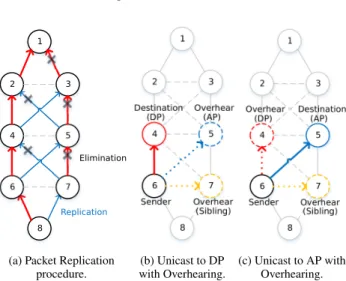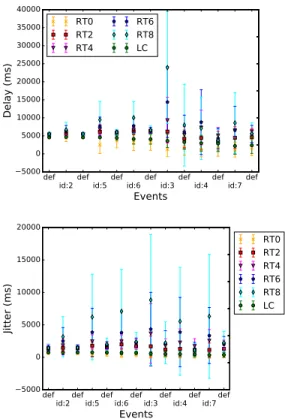HAL Id: hal-01419907
https://hal.inria.fr/hal-01419907
Submitted on 6 Jun 2018
HAL is a multi-disciplinary open access
archive for the deposit and dissemination of
sci-entific research documents, whether they are
pub-lished or not. The documents may come from
teaching and research institutions in France or
abroad, or from public or private research centers.
L’archive ouverte pluridisciplinaire HAL, est
destinée au dépôt et à la diffusion de documents
scientifiques de niveau recherche, publiés ou non,
émanant des établissements d’enseignement et de
recherche français ou étrangers, des laboratoires
publics ou privés.
Poster: 4th Industrial Revolution: Toward Deterministic
Wireless Industrial Networks
Tadanori Matsui, Georgios Papadopoulos, Pascal Thubert, Thomas Watteyne,
Nicolas Montavont
To cite this version:
Tadanori Matsui, Georgios Papadopoulos, Pascal Thubert, Thomas Watteyne, Nicolas Montavont.
Poster: 4th Industrial Revolution: Toward Deterministic Wireless Industrial Networks. EWSN 2017 :
International Conference on Embedded Wireless Systems and Networks, Feb 2017, Uppsala, Sweden.
2017. �hal-01419907�
Poster: 4th Industrial Revolution:
Toward Deterministic Wireless Industrial Networks
Tadanori Matsui
Nishi Hiroaki laboratoryKeio University, Japan
matz@west.sd.keio.ac.jp
Georgios Z. Papadopoulos
IRISAT ´el ´ecom Bretagne, France
georgios.papadopoulos@
telecom-bretagne.eu
Pascal Thubert
Cisco Systems Francepthubert@cisco.com
Thomas Watteyne
EVA team Inria, Francethomas.watteyne@inria.fr
Nicolas Montavont
IRISAT ´el ´ecom Bretagne, France
nicolas.montavont@
telecom-bretagne.eu
Abstract
Critical applications such as industrial process control, smart grid and vehicle automation require networks which offer on-time data delivery and wire-like end-to-end reliabil-ity. This paper proposes to exploit path diversity to com-pensate for the lossy nature of the wireless medium. We in-troduce “Leapfrog Collaboration”, a communication mech-anism in which multiple copies of the same packet traverse the network on disjoint paths. Emulation results on Cooja show that, compared to single-path transmission, this tech-nique reduces end-to-end delay by up to 28%, and jitter by up to 58%.
Keywords
Multi-path Routing Algorithm, Route Diversity, Deter-minism, Leapfrog Collaboration.
1
Motivation
Industry 4.0 re-uses Internet of Things (IoT) technol-ogy to simplify production chains, simplify deployment, and make the factory floor more flexible and adaptable. It heav-ily relies on deterministic networking technology, in which the network guarantees the information is carried with pre-defined and predictable delay, regardless of link quality and the network usage. One important goal for the network is to offer near-zero jitter. Current IoT technology builds on best-effort packet switched network, which introduces vari-able network delays because of retransmissions and queuing. In 2016, a new version of the IEEE802.15.4 standard [1] was published. It introduces Time-Slotted Channel Hoping
1 2 3 4 8 Replication Elimination
(a) Packet Replication procedure.
(b) Unicast to DP with Overhearing.
(c) Unicast to AP with Overhearing.
Figure 1: Replication, Elimination and Overhearing operations.
(TSCH), a new Medium Access Control (MAC) mode de-signed for demanding industrial applications. In a regular TSCH network, a packet follows a multi-hop path between source and destination. Between some neighbors, when the link is poor, the same link-layer frame can be retransmitted multiple times. This increases end-to-end delay and jitter.
This paper proposes to enhance the forwarding mecha-nism: multiple copies of the same packet travel on disjoint paths through the network. This technique exploits path di-versity. Because the first copy that reaches the destination is the one that counts, Leapfrog Collaboration lowers end-to-end delay and jitter.
2
Leapfrog Collaboration
IEEE802.15.4 TSCH offers a resource reservation mech-anism which allows hop-by-hop scheduling when combined with the RPL [2] routing protocol. Since wireless is unreli-able in nature, frames are retransmitted if no link-layer ac-knowledgment is received. Retransmissions increase delay, energy consumption and bandwidth. In some environments,
defid:2defid:5defid:6defid:3defid:4defid:7def
Events
−5000 0 5000 10000 15000 20000 25000 30000 35000 40000De
lay
(m
s)
RT0 RT2 RT4 RT6 RT8 LC defid:2defid:5defid:6defid:3defid:4defid:7def
Events
−5000 0 5000 10000 15000 20000Jitt
er
(m
s)
RT0 RT2 RT4 RT6 RT8 LCFigure 2: Average end-to-end delay (top) and jitter (bottom).
losses can even be bursty, i.e. the link quality between two neighbors suddenly drops for some time. Consecutive re-transmissions on the same frequency do not help in this case. RPL does come with a fail-over mechanism, but the delay to discover and use an alternate path can be long (in the order of seconds). Rather than recomputing the path, we duplicate packets along disjoint paths.
We use Fig. 1 to illustrate how Leapfrog Collaboration works. In this figure, node 8 wants to send data to node 1. Each node in the network maintains two parents: its De-fault Parent (DP) and Alternate Parent (AP). Leapfrog col-laboration works best if the two paths of default parents (8 → 6 → 4 → 2 → 1 and 8 → 7 → 5 → 3 → 1 in Fig. 1) are disjoint. It also works best if the default and alternate parents hear one another and if they have the same ancestor. Each node on the Leapfrog Collaboration path does the same: it sends two copies of the same packet, one to the DP, one to the AP. Packets contain a unique counter, and node maintain a buffer of recently-heard (source IPv6 ad-dress, destination IPv6 adad-dress, counter) tuples. If a node re-ceived a packet already present in its buffer, it silently drops it (elimination). If, however, the packet is new, it forwards it to both DP and AP (replication).
From a TSCH point of view, each node has dedicated cells scheduled to its DP and to its AP. A node’s sibling also schedules cells to overhear those cells. If, when listening to those cells, siblings hear a packet it has not heard before, it participates in Leapfrog Collaboration as if it had received it from its child.
By having multiple copies travel from source to destina-tion in a “band” of nodes – rather than a single string of nodes –, latency and jitter are reduced. This is because latency/jitter are measured on the first copy of the packet. Leapfrog Col-laboration exploits path diversity so the first copy arrives faster than if a single copy was sent in the first place.
3
Performance Evaluation
Setup. We implement Leapfrog Collaboration on Con-tiki OS1and run simulations on Cooja, with emulated
Zol-ertia Z12nodes. We use the topology from Fig. 1, deployed on a 40 m × 10 m area. Node 8 transmits 1 data packet ev-ery 10 seconds to node 1. Transmission power of all nodes is set to 0 dBm. We use the RPL protocol to construct the routing structure. We use a single IEEE802.15.4 TSCH slot-frame with 101 timeslots. We compare the performance of Leapfrog Collaboration against that of the default RPL pro-tocol (i.e. a single copy travels through the network). On the base implementation, we vary the maximum number of link-layer retransmissions: RT2 means that the TSCH imple-mentation will re-transmit at most twice in case no link-layer acknowledgment is received.
Delay. Fig. 2 shows the average end-to-end delay3 for both Leapfrog Collaboration and the base TSCH implemen-tation (RTx, where x is the maximum number of link-layer retransmissions). Leapfrog Collaboration reduces the end-to-end delay when compared to the retransmission-based ap-proaches of IEEE802.15.4-TSCH (i.e. RT2, RT4, RT6 and RT8). Indeed, it decreases by up to 28%, 41%, 46% and 54%, respectively.
Jitter. Jitter is calculated as the time of consecutive packet inter-arrival from the source node to the destination. Fig. 2 shows the average end-to-end jitter. The results con-firm that packet retransmissions impact jitter: the higher the retransmissions, the higher is the jitter (i.e. RT8 shows re-sults over 5000 ms). Leapfrog Collaboration exhibits low (i.e. 600 ms) and stable jitter throughout the simulation life-time. It reduces jitter by up to 58%, 71%, 77% and 84% when compared to RT2, RT4, RT6 and RT8, respectively.
4
Conclusion
Industry 4.0 is considering standard IoT technology to replace or extend wired networking systems. Recent IEEE802.15.4 changes provide a framework for QoS, but delays are hard to guarantee in lossy packet switched net-work. This poster introduces Leapfrog Collaboration: send-ing multiple copies of the same packet on disjoint paths low-ers latency and jitter by exploiting path divlow-ersity, a statement which is confirmed by simulation results.
5
References
[1] IEEE Standard for Low-Rate Wireless Personal Area Networks (LR-WPANs). IEEE Std 2015 (Revision of IEEE Std 802.15.4-2011), April 2016.
[2] T. Winter, P. Thubert, A. Brandt, J. Hui, R. Kelsey, P. Levis, K. Pister, R. Struik, J. Vasseur, and A. R. RPL: IPv6 Routing Protocol for Low-Power and Lossy Networks. RFC 6550, IETF, 2012.
1http://www.contiki-os.org/
2http://zolertia.io/z1

